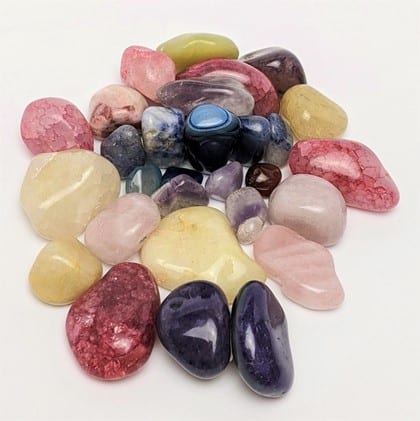
Lapidary is a century’s old, ageless art of cutting and polishing various kinds of stones. This art dates back to pre-historic times when the early humans cut and polished tools for hunting from stones.
Later, polished and shaped stones started to be used as personal adornment and also were included in rituals. Lapidary is found in several cultures around the world, and it is difficult to pinpoint its actual origin.
In the 1950s, lapidary was taken up as a hobby in the United States of America and gained much popularity. Hobbyists who enjoy working with stones, cut, polish, and mount semi-precious or precious stones in different jewelry settings or metal blanks.
What does lapidary involve?
Lapidary involves cutting rough stone cutting, grinding them to give smoother edges and desired shapes, and even sawing raw stones into smaller, workable portions. It also includes cutting facets or faces into stone to give them a better look and clearer surface. But, this is just one process of lapidary art. Polishing, buffing, and setting are the final steps of lapidary.
Who practices lapidary?
Lapidary is practiced by hobbyists as well as professionals who are in the jewelry business. They may cut, polish, and set stones to make final jewelry pieces or only cut precious gemstones for collectors or other jewelers.
What are the most common lapidary techniques?
Four of the most common techniques of lapidary techniques art are
Tumbling
The idea of tumbling to get polished, pretty looking stones may find its origin in nature. The idea may have sparked, inspired by the tumbled rocks that rivers carry. This method involves the same science under artificial circumstances.
Usually, tumbled stones are rounded, small, look bright and polished, with smooth edges. That’s why they are known by different names like ‘tumbled gems’, ‘polished rocks’, ornate or ‘baroque gems” and many others. The machine in which the rough rocks are turned into round stones is called a “rock tumbler”.
Tumble stones look pretty and attractive. They are often set in necklaces, earrings, gifted as a souvenir, home décor, used in crafts, and also preserved as collectibles. Not to forget, tumbled stones often play a major role in spiritual healing. Some rocks and minerals that are suitable for tumbling and are popular as tumbled stones are
- Agate
- Amethyst
- Basalt
- Bloodstone
- Citrine
- Garnet
- Granite
- Sunstone
- Tiger’s Eye
- Turquoise
- Rose Quartz
Some fossilized materials like Mookaite, fossil wood or petrified wood, Silicified coral are also tumbled by stone cutters.
Rock tumblers used by hobbyists are small and compact, but the commercial stone tumblers are often big enough to tumble two tons and more at one go!
Faceting
Cut diamonds and colorful gemstones look magnificent, but the process that’s involved in turning rough rocks into precious stones that are fascinating. It’s a combination of art and engineering. Craftsmanship paired with technology allows creating these wonderful gems. The exemplary look of faceted gemstones may make you think it’s an extremely complicated process. But, most people who have a knack can learn the complex process through guided instructions.
Height, angle, and index are the most important things to follow in faceting. The appraisal of faceted stones is mainly based on 5 P’s.
- Points
- Proportions
- Polish
- Positioning
- Performance
Some of the best gemstones to choose for faceting by beginners are garnet, quartz, tourmaline, zircon, peridot, topaz, etc. Faceted stones are designed into a variety of shapes like round, triangle, baguette, heart, pear, and many more.
Cabbing
Cabbing, also popularly known as cabochon cutting, is probably the most admired form of gem cutting. This process needs certain degrees of expertise but is not an unattainable task for beginners.
This technique of lapidary or preparation of cabochons is used to turn rough rocks into oval-shaped and well-polished pieces. They are then used in jewelry and collection stones. Cabochons, also known as “cabs” make an attractive way to exhibit minerals like agate, jasper, petrified wood, that takes a superior polish.
This technique involves rough cutting of minerals into desired shapes and then sanding to smoothen out the edges. The last step involves polishing them to add a smoother look on a well-rounded surface.
Carving
Carving on gemstones is an age-old art and is making a comeback. It began in ancient civilizations in Persia, Rome, Egypt, and India. Gemstones with carved designs often represented symbols of emperors, kingdoms, or even cults. They were minutely hand-carved with simple tools. Those gemstone artworks often lacked polish as the different symbols meant something in particular rather than for their ornamented look. The art of gemstone carving is a boundary-less, timeless technique that has been practiced in different cultures for thousands of years.
With the passage of time, the beauty of hand-carved gems brought them into popularity and became a luxury among the aristocratic classes. It was also often seen in famous architectural structures like the Taj Mahal, in India built during the Mughal rule.
During the 19th century, new techniques of gem cutting came into existence, and by the 20th century, the art lost its popularity.
In modern times it once again came into the limelight. The desire to augment each stone carving work with more luster and shine gave birth to new techniques and technology. Inscription of letters, floral motifs, butterflies, and other nature-oriented patterns are most popular in stone carving.
Carving is often done on softer stones. Emerald, tourmaline, garnet, and amethyst are popularly chosen for this artwork. However, softer stones are difficult to handle, and that results in wastage and breakage. That is one of the major reasons why carved stones are extremely expensive.

Various processes involved in the lapidary process
The different techniques of stone cutting involve various processes like
Sawing
This process involves taking out stones from the earth or quarrying and then shaping them by cutting them into desired sizes. The examples of rock-cut architecture are many. The pyramids, obelisks, Angkor Wat, numerous Indian temples, Casa Mila in Barcelona, the Colosseum of Rome, are some famous stonework from around the world. In olden times, stones were extracted and then cut with chisel and hammer. Tools made of bronze were often used to cut softer rocks like limestone.
Modern-day stone quarrying and sawing differ vastly from ancient times. Some of the stone cutting methods include
- Feather and Wedge Technique
- Hydraulic Guillotine
- Wire Saw
Grinding
The process of grinding allows smoothening out the edges and to shape the rock. Larger pieces can be better ground with a hand grinder. There are several kinds of machines available for this process. Some of the popular tools are
- Cup wheels
- Drum wheels
- Grinding disc
- Sizing wheel
The desired result is to smoothen out the rough surface without chipping. That’s the reason most of the tools use high power. Along with grinding, most of these tools have other functions too. Lapidary enthusiasts can use them for chamfering, making slots and grooves, beveling, etc.
Drum wheels as well as vertical wheels mostly come into use in large machines that are meant for surface grinding. The purpose of surface grinding tools is to give a smoother finish after the initial coarse stone grinding process.
Lapping
The process of lapping is somewhat similar to sanding. Although it is like grinding, the difference is, it is done with a rotating disc on one side called a “lap”. Usually, this process is used to get the stone ready with a flat surface for the ease of faceting. Laps are usually made of steel, metal alloys, cast iron.
Polishing
A hobbyist or a professional gemstone cutter, a lapidary enthusiast needs polishing tools wheels. In earlier times, polishing was done with pewter made mills. Not so long ago, various metals like copper and lead are used along with water or oil and abrasive material to polish gemstones. The abrasive surfaces used are often oxides, diamond dust, or emery paper.
Inlaying
Inlaying is an important part of the lapidary as it gives the final look to jewelry, interior stone décor, or other stone trinkets. Stones and minerals like agate, jade, jasper, onyx, lapis lazuli, amethyst, Tiger’s eye, coral are popular in inlay work. Historical monuments like the Taj Mahal bears examples of fascinating inlay work. Tabletops, coasters, jewelry are some of the things where stone inlay techniques are used.
In jewelry-making, metal channels, wire bases, or cases of different sizes are made for inlay. It’s an art to position the gem in a holder, to set it, and secure it. In the end, “gem-studded jewelry” is what we call them! From expensive diamond jewelry to boho chic, fashion trinkets, stonework plays an important role in making fashion statements.
Some interesting facts about lapidary
- Thailand and Sri Lanka are the two major stone cutting countries globally.
- Some of the oldest lapidary works were made with stones like jade, turquoise, quartz, sapphire, etc.
- Turquoise was one of the favorite lapidary stones in different cultures from Tibetans, Egyptians to Native Americans.
- Blue sapphire was cut and polished as a healing stone to soothe tired eyes and augment vision.

